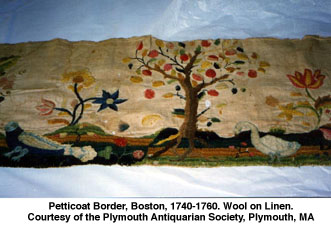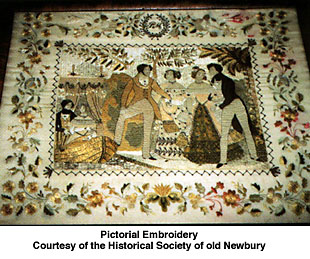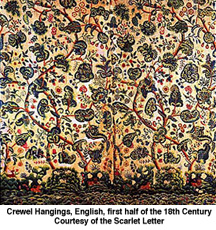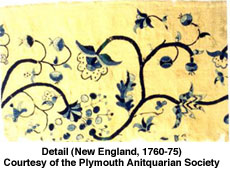

In 1600 Queen Elizabeth of England signed the charter for
The East India Company opening up trade with the Far East which
then introduced painted cottons called palampores. Designs for
these eventually were dictated by English fashion but translated
by Indian painters where they evolved into the fantastic tree
of life with multiple flowers and leaves often growing from Chinese
style mounds. Crewel work exploded into fantasy bed hangings
with a palette of greens and blue greens, oversized leaves, birds
and animals. The stitching became a contest of pattern and motif,
with each leaf competing against the next for variety. This was
not the only crewel style available during the 17th century but
it is the most memorable. As the century progressed, the style
lightened, becoming more graceful for its move to America.

American women in the 18th century took crewel to their hearts
producing their simplified but original style of bed hangings,
pockets, pocketbooks, petticoat borders, chair seats etc. The
amount of crewel remaining in collections today attests to the
devotion and industry of American women. Design became regionalized
with mounds and prancing animals remaining popular near the seacoast,
while blue and white scattered patterns were favored in the Connecticut
Valley region. The stitches also changed as they moved from England;
long and short to the faster self couching stitch also called
New England laid or Roumanian. By the third quarter of the 18th
Century, crewel faded as women became overwhelmed with the American
Revolution.

The next revival of crewel started in England when William
Morris and his idealistic buddies, among them Edward Burne Jones,
led a back to the earth movement in the mid 19th century. His
marriage to Jane Burden and the establishing of their home was
the pivot that steered Morris to his devotion and study of the
decorative arts. His work with crewel caused his frustration
with dyes of the industrial revolution driving him to investigate
and experiment with natural dyes to recreate the palette of blues
and blue greens used in the past. Embroidery was one tiny part
of Morris's involvement as a designer, who along with Rosetti,
Burne Jones and others, began the Arts and Crafts Movement. Remember
each revival redefines techniques and design. William Morris
expanded medieval design to reflect his generation and need.
The long and short stitch was nicknamed the Kensington stitch
and a cottage industry was formed to produce the embroideries.

Once again the ocean was no barrier for new ideas. Margaret
Whiting and Ellen Miller of Deerfield, Massachusetts, under the
influence of Englishman John Ruskin, formed The Deerfield Blue
and White Society in 1898, for the production of embroidery based
on 18th century crewel examples. As Morris had before them, they
experimented with dyes to produce color fast indigo blues and
madder roses on linen threads rather than wool to avoid moth
damage. They were recognized in their time as part of the American
Arts and Crafts movement and continued with their cottage industry
until World War I changed the world's direction. Candice Wheeler,
another recognized embroiderer of the American Arts and Crafts
movement, actually preceeded the Deerfield Blue and White Society.
As part of the Society of Decorative Arts in New York along with
Louis Tiffany, she designed and stitched in wools along with
silk surface embroidery. Her work is represented in the Metropolitan
Museum of Art.

The first wave of craftspeople to develop after both wars'
destruction was in the 1960's. That back to the earth movement
moved embroidery, pottery and other decorative arts from its
quiet existence to, once again, its place of prominence and respect.
This generation's gods have not yet been selected. Embroidery,
at one time the equal of fine art, has developed technicians
and now waits for the next revival, whether of crewel or another
medium.
The following examples of crewelwork were provided by The
Plymouth Antiquarian Society with our special gratitude to Donna
Curtin, Executive Director, for her research efforts and generosity
in providing us with historical crewel work from the Society's
collection.
Detail of bed hanging fragment, New England, 1760-75. Wool
on wool, absract blossoms in monochromatic indidgo.
Petticoat Border (shown as trytych), Boston, 1740-60. Wool
embroidered on linen. Pastoral scenes of trees, flowers, birds
and animals, sometimes referred to as the "Fishing Lady"
style.
Crewel pocketbook, 1763. Wool embroidered on linen canvas
with wool tape edging and silk lining. Belonged to Revolutionary
patriot Ephraim Spooner of Plymouth, MA, whose name is stitched
on the green border panel below purse clasp.
Petticoat border, 1725-50, Boston area. Wool embroidered on
linen. Floral pattern with few repeating motifs.
The following crewel work was provided courtesy of The Scarlet
Letter with special thanks to Marsha Van Valin:
A Crewelwork Hanging, English, First Half of the 18th Century
- Embroidered in colored wools with sinuous branches sprouting
out-sized foliage and stylized flowers rising from an imbricated
ground, with various animals, including a stag, lion and four
rabbits.
The following crewel work was provided by the Old York Historical
Society in York, ME, with special thanks extended to Scott Stevens,
Executive Director, and Cheryl Farley, Community Relations Director,
for sharing these priceless treasures with us.
Bedhangings of woolen crewel embroidery on unbleached linen,
worked by Mary Swett Bulman of York, ME, circa 1745. This is
the only complete set of American crewel embroidered bedhangings
to have survived from the 18th century, consisting of 6 valences (an interior and exterior set) and there is a tester as well.. The colors remain incredibly
vibrant and have been maintained in a remarkable state of preservation.
Textile scholars consider them to be the most important extant
examples of 18th century American needlework.
The pictorial embroidery shown was provided by the Historical
Society of Old Newbury, with special thanks to Jay Williamsion
for permission to display it on our website
The author, Elizabeth Creeden, is the proprietor of a needlework
shop, The Sampler, in Plymouth, MA. She is a reknowned authority
on crewel and has been enormously instumental in reviving interest
in this technique. Not only is she dedicated to preserving historical
examples of crewelwork, but she is herself a designer of original
crewel patterns and has reproduced period pieces of all kinds
for museums, public and private historic organizations, and private
homes.For more information on Elizabeth Creedon, see our Shop
Focus this month on The Sampler.
The Plymouth Antiquarian Society was founded in 1919 by a
group of women volunteers dedicated to preserving historic American
houses and artifacts. Located in Plymouth, MA, the Society maintains
an extensive collection of fine furnishings, domestic objects
and textiles and operates three historic houses museums. For
information about membership or to receive a calendar of events
and programs, please contact the society at P.O.Box 3773, Plymouth,
MA, 02361, call them at (508) 746-0012 or e-mail them at pasm@ici.net
For more information on the Scarlet Letter, see the Feature
Story and Gallery Feature on Samplers Part II in our site archives
or visit their site at http://www.scarlet-letter.com
At the Old York Historical Society you can get an intimate
view of three centuries of life in a distinctive coastal Maine
Village. Discover the town's rich architectural, cultural, and
maritime heritage as you experience tours of historic buildings
located in the center of York and along the riverfront where
the town was founded in the 1650s. Choose a tour led by a costumed
guide through one or several museum buildings showcasing over
three hundred years of furnishings and accessories that tell
the story of life in York as it used to be. The Old York Historical
Society can be contacted by phone - (207) 363- 4974, by e-mail
- oyhs@oldyork.org or see
their website - http://www.oldyork.org
The purpose of the Historical Society of Old Newbury is to
preserve and perpetuate the history of Old Newbury. Artifacts
in the museum have been donated by residents in the community
and the Museum maintains a truly exceptional collection of furniture,
painting, china, toys, fans, silver, clocks, clothing and needlework,
displayed in rooms typical of the 19th century. The museum is
located at 98 High Street in Newburyport, MA. For more information,
please call (978) 462-2681.
FOR ADDITIONAL READING
Plain and Fancy, Susan Burrows Swan, Holt Rinehart and
Winston, NY, 1976
American Needlework, Georgiana Brown Harbeson, Bonanza
Books, NY, 1938
Deerfield Embroidery, Margery Burnham Howe, Charles Scribner's
Sons, NY, 1976
English Domestic Needlework, Therle Hughes, Abbey Fine
Arts, London, 1900
Girlhood Embroidery, Betty Ring, Alfred A. Knopf, NY 1993
COPYRIGHT NOTICE: No part of this feature story nor
the included designs can be reproduced or distributed in any
form (including electronic) or used as a teaching tool without
the prior written permission of the CARON Collection Ltd. or
the featured designers or contributors.

